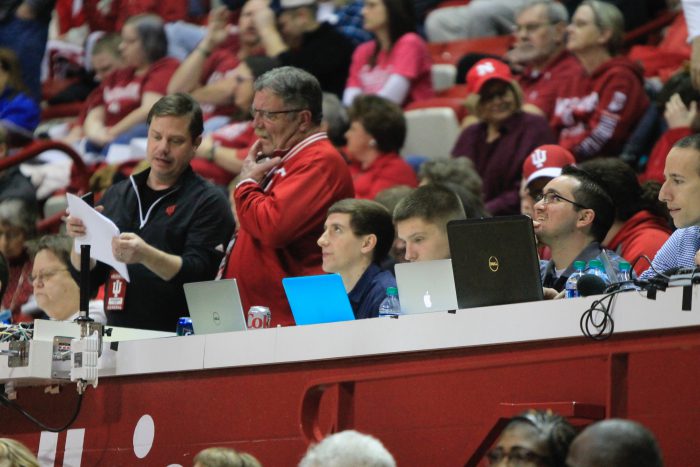
What’s not changing in sports journalism Although the interview data suggest a number of significant changes to how sports journalists do their jobs, it would be incorrect to say that the entire profession is changing. In fact, the interviews suggest that there are aspects of the job that are not changing despite the emergence of digital and social media.
Last week’s series noted the changes to sports journalists’ day-to-day work routines, one routine that hasn’t changed is the daily deadline. The data suggest that the daily deadline remains the defining difference between newspaper journalism and online journalism. The sports journalists interviewed said that no matter how digitally oriented their organization is, there was still a daily deadline they had to meet – usually between 10:30 p.m. and midnight. That is a constraint they operate under that online sports journalists and bloggers do not have, because they are not bound by a print production. The lack of a deadline means online journalists can spend more time reporting and writing after a game to file a story that can be posted overnight, rather than hitting a midnight deadline, or they can post a story the next afternoon. Writers for blogs like Deadspin and Bleacher Report have a similar work structure. Bloggers for these sites can post whenever they want, be it immediately after a game or long after it ends. But newspaper sports journalists still must produce a story by deadline. No matter how digitally oriented their work is, they still must have their stories done on time, and they still must produce pages and send them to the presses on time.
All 12 reporters interviewed self-identified by the beats they covered (including the columnists, who identify as such). The beat is how a reporter defines his or her professional identity. It shapes how they see themselves, and how they see their professional world. All 25 journalists, both reporters and editors, said that their paper had some sort of beat structure. The interviews show that the beat system is an ingrained part of the profession, echoing Fishman’s finding about news journalism and suggesting an institutionalized aspect of the profession. Reporters are responsible for covering their beat the same way a news reporter is responsible for covering city hall or the police beat. As Fishmanfound decades ago with news reporters, sports journalists are expected to provide daily coverage of their beat regardless of how much or how little is going on. A reporter can’t attend a game and not file a story because he or she found the game uninteresting, or because the home team lost. The norm of sports journalism is to provide daily coverage, win or lose. That is a norm that remains a part of the profession.
In general, news values in the digital and social age appear to be very similar to those of the print era. Sports journalism is often defined through game coverage. A sports department’s schedule still mirrors the local sports teams’ game schedules. Much in the way a crime reporter’s day revolves around the court schedule or a political writer’s work day revolves around the many meetings of government agencies, a sports journalist’s schedule revolves around the games on his or her beat. If there are no games going on in the area, it’s considered a slow night, no matter what else might be happening in the sports world.
Game coverage tends to revolve around the so-called major sports—football, basketball, baseball, and hockey. Pro and college football tend to be the most popular sports, as defined by sports journalists and editors. Within high school sports, football was the most popular sport at every newspaper interviewed. Story selection echoes what Lowes found in his ethnography of a Canadian newspaper’s sports section. Sports coverage tends to focus on mainstream team sports, nearly all of which are male. Coverage of women’s sports has increased, but it is still not at the level of men’s sports and it was one of the first casualties of the industry’s economic struggles. With the exception of high-school girl’s sports, women’s sports coverage exists on a lower tier of importance than coverage of men’s sports. Editors held niche and individual sports like running, hunting and fishing in low esteem. They were seen as section filler, not as legitimate sports worthy of sustained coverage.
The sports journalists interviewed indicated that they are generally writing the same types of stories, interviewing the same kinds of sources, gathering the same kinds of information, as they were in the pre-digital world. This finding echoes Chris Anderson, who found that many of the essential acts of journalism have not changed in the digital era. Story judgment reflected the news values traditionally found in news stories—deviance, proximity, timeliness, and impact. Of these, the interviews make it seem that proximity matters most. Reporters and editors focus their energy on covering local sports, whether local is defined by geographic proximity or by the interest of fans in the area. The interview data suggest that decisions about story selection are almost second nature and automatic to reporters and editors. The decisions are product of training and experience, and an example of what organizational sociologists call normative isomorphism, the notion of a shared set of norms, values, and practices that cut across individual organizations and a part of a profession. Those norms and values do not appear to be widely changing in the digital age. Story judgment and source selection is an example of institutionalism]) and reflects the idea of tacit knowledge. Reporters may not be able to say why they do something (one writer likened it to muscle memory), but they just know it’s the way they do things.
Stories and columns tend to focus on games and feature primarily the voices of star players and coaches. A coach’s voice will almost always appear in a story, as will a star player. For game coverage, reporters will interview the coach and any players who had a key role in the game, and often that is the star player. Again, this echoes previous research that sports journalism is star-focused. These source-journalist relationships are generally positive, and the source-journalist relationship is central to journalism. The data in this study show that the centrality of the sports-journalist relationship is also central to sports journalism. Access to coaches, players, team officials and other sources is seen as crucial, which is why the reporters and editors interviewed were so upset about the shrinking access teams were providing to the media. The routine is changing, in the form of less access, but the norm and value remains the same, in that access is considered a critical part of a sports journalist’s job. Teams are able to act as publishers through their own official websites, and players and coaches can communicate directly with fans via social media, which reduces the incentive for players to cooperate with media (beyond league-mandated regulations) and leads to reduced access for reporters. The issue of access appears to be one of the central conflicts facing sports journalists in the digital age. Their professional norms and values still require access to sources, but the routine is changing in the form of limited access. Rather than the routine reflecting the norm or value, the evolving routine is now in conflict with the norm/value.
The interviews also reinforce the notion of normalization. When confronted with new publishing technologies like blogs and social media, journalists tend to adapt the technology to existing norms, routines, values, and practices rather than changing their work practices to best fit the new media platform. This is happening in sports journalism. Sports journalists are using digital media as an extension of their traditional professional work rather than creating new kinds
of journalism. They’re using established journalism values and ethics in their use of digital media. Normalization reflects how the sports journalists’ routines are changing but the underlying norms and practices remain the same. Sports journalists using Twitter as a part of their job reflects a changing routine, but normalizing it — as the name suggests — reflects the relatively stable norms and values.
The idea of norms and values not changing at the same rate as routines is important because it may explain why sports journalism (and, by extension, all journalism) has struggled so much with the transition to the digital and social worlds. When it comes to traditional journalism, sports reporters and editors know what they’re supposed to do. They know what traditional journalism is supposed to look like. They’ve learned by doing throughout the years, from established principals and from established practitioners—schools, older reporters, an internship system. But in online journalism, there are no established, institutionalized norms for how to conduct online journalism. There are no norms and values that have been passed on through generations of reporters on busy Friday nights. The interview data suggest this lack of institutionalized norms in online journalism (compared to print journalism) is creating a sort of knowledge vacuum in sports journalism, where reporters and editors fill in the blanks with their own opinions of what should be done based on existing norms, rather than examining what would be the best use of new platforms and technologies. In a sense, the established norms and values of sports journalism potentially constrain the profession from moving forward.
It’s potentially easy to view the Internet’s impact on sports journalism as what sociologists call a competence- destroying technology, one that has totally rendered the previous order as obsolete and completely changed the paradigm in which sports reporters and editors operate. But the interviews paint a more nuanced picture. The interviews suggest the basic acts of journalism are not changing. Reporters are still reporting. Editors are still assigning, budgeting and editing stories. Much of the content, many of the decisions, are the same or similar to previous generations. There is evolution — reporters and editors both said they are looking for game stories to be more analysis than recap, but game coverage itself remains an essential act of sports journalism. As such, looking at the Internet as either strictly a competence-enhancing or competence-destroying technology to sports journalism does not provide a full understanding. Here, it is important to make a distinction between sports journalism as a profession and sports journalism as an industry. It appears that digital media has been a competence-destroying technology for the journalism industry as a whole. The number of jobs that have been lost, the losses of advertising and circulation revenue, are all indicative of an industry that is in the middle of an upheaval.
The interviews with sports journalists reflect this, as a number reporters and editors had had their jobs affected by layoffs at their paper. Digital media is fundamentally changing how news is published and consumed. It’s making everything that came before it obsolete—one of the hallmarks of a competence-destroying technology. But as the interview data show, it has not had the same effect on the profession of sports journalism. Although the jobs of sports editor and sports reporter are evolving due to digital media, the interviews do not show drastic changes in the profession. Sports journalists are still covering many of the same stories and using many of the same sources as they were in the pre-digital era. This is not the sign of a competence- destroying technology, in which the previous order is rendered obsolete by the new technology. It’s also not the sign of a competence-enhancing technology, because digital and social journalism is not an obvious, order-of-magnitude improvement on print. The existence of an ongoing conversation and debate about the effectiveness of digital journalism demonstrates that it is not a competence-enhancing technology (in which the improvement would be so clear, there’d be no debate). Digital media’s effect on sports journalism as a profession is a little more nebulous than its effect on the industry of sports media. That distinction is important to consider. Digital media may be competence-destroying for the sports media industry, but not for sports journalism itself.
(This is the part of a series of blog posts about sports journalism that comes from my 2014 dissertation, “The Story vs. The Stream.” Since it’s been a few years, and what’s been peer-reviewed and published from this is already out there, I’d rather post some of my findings here rather than let them linger in some library forever.)


